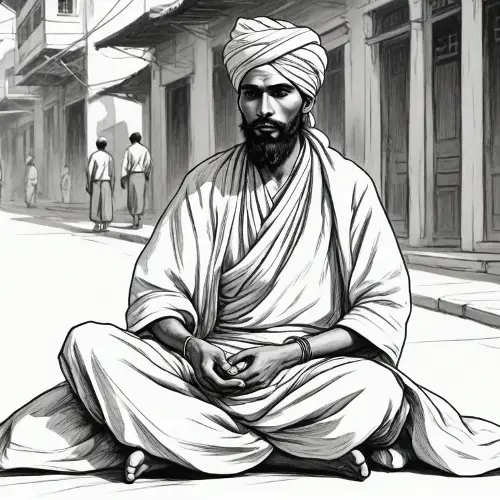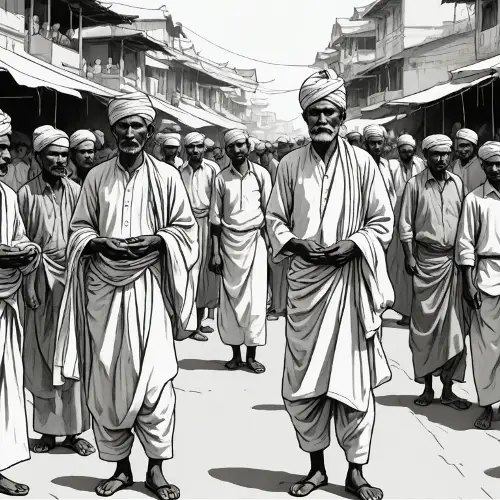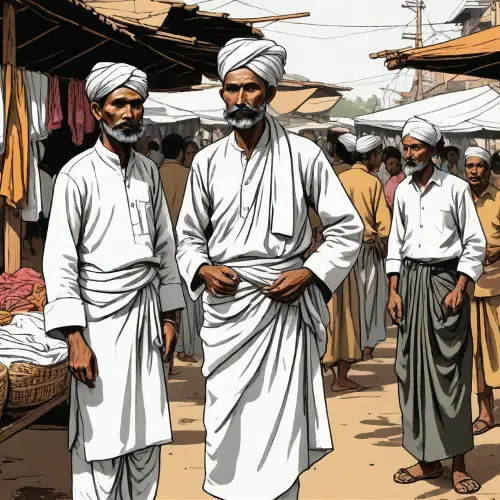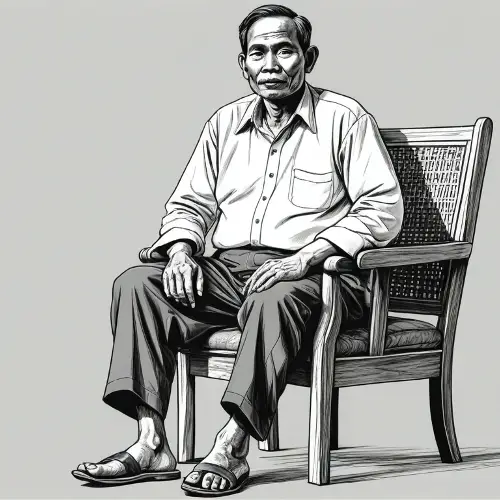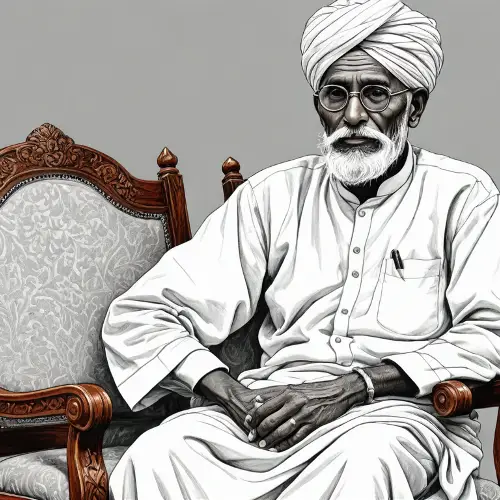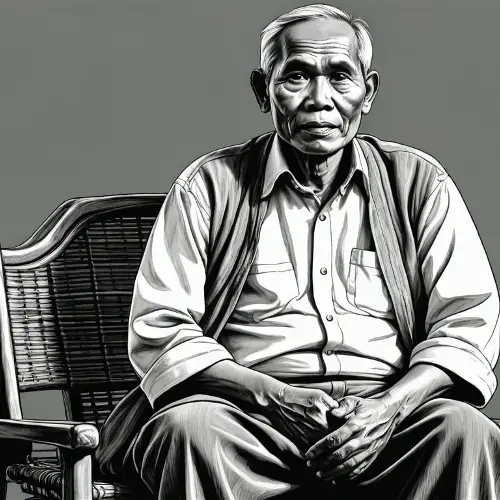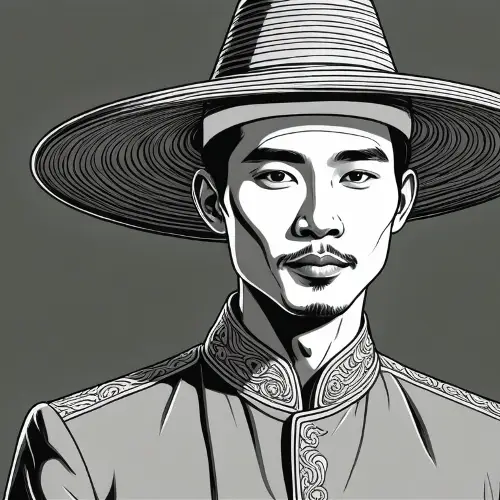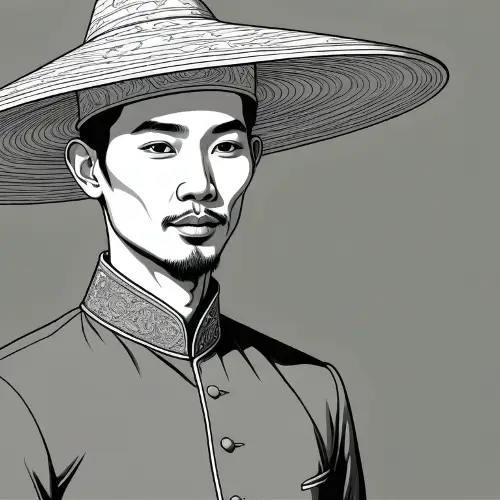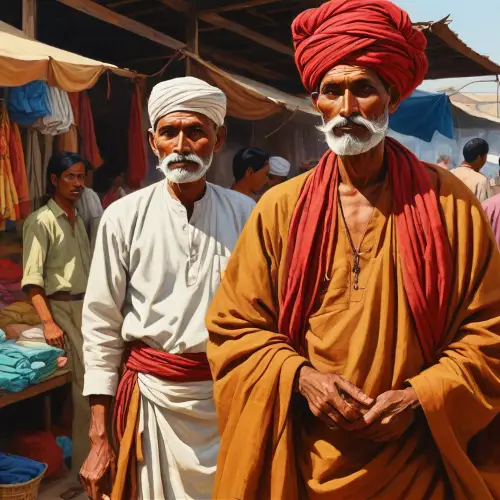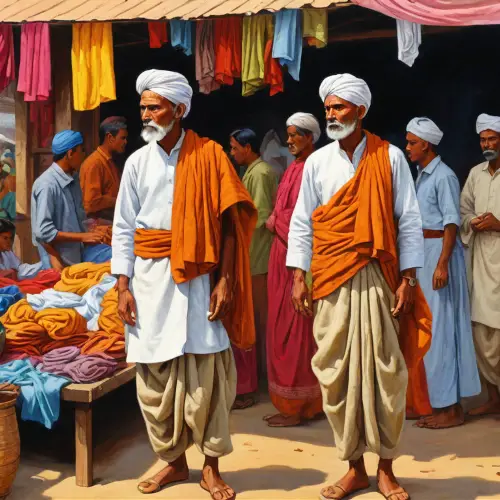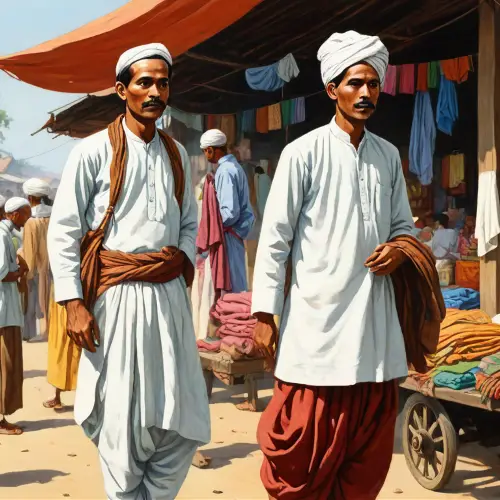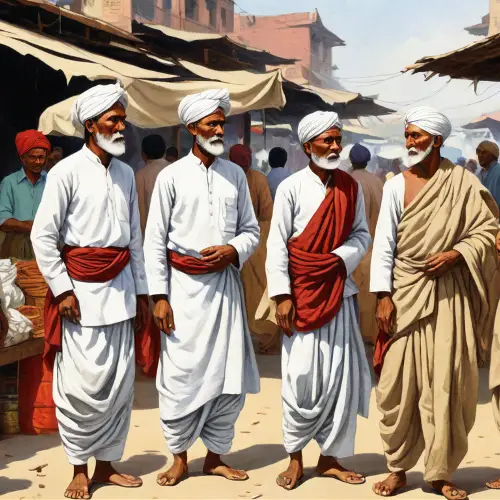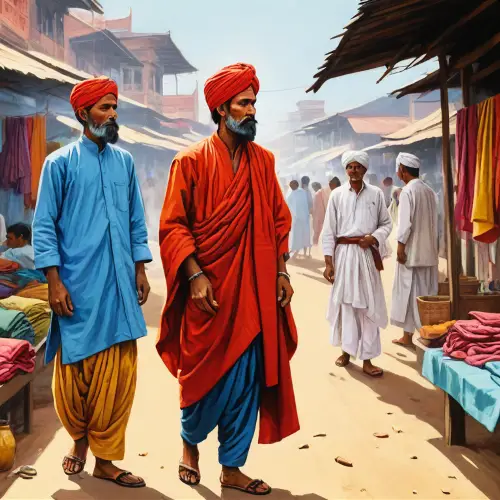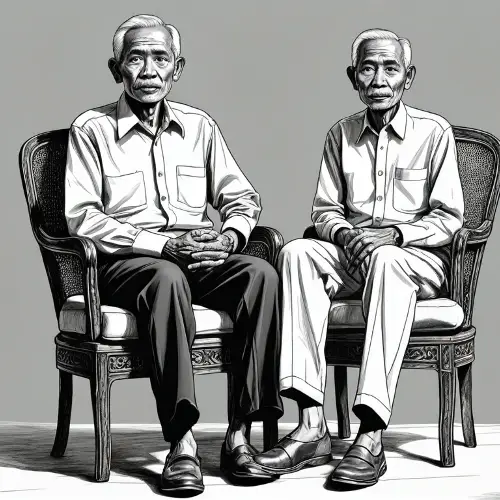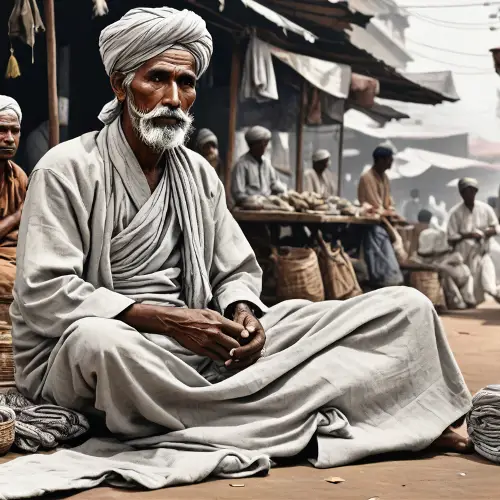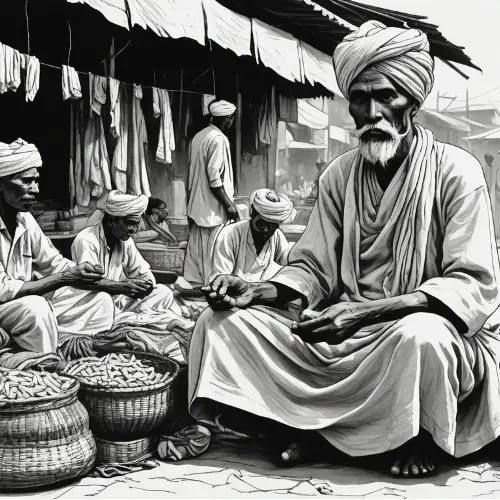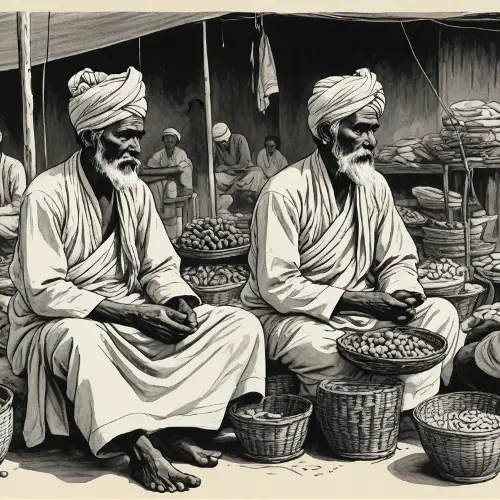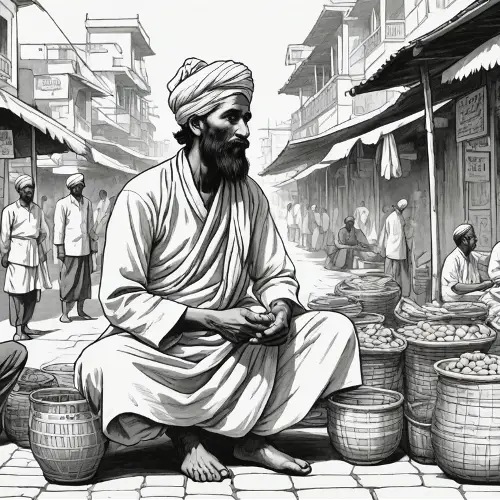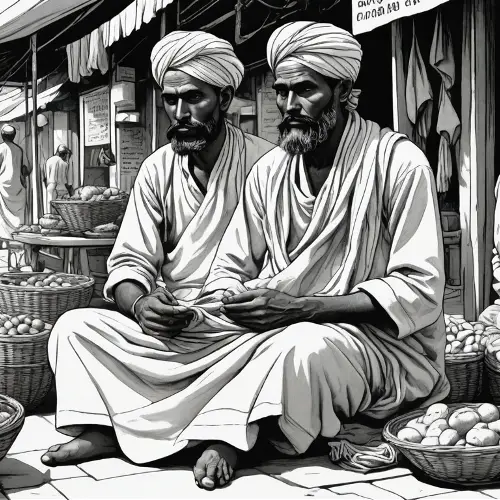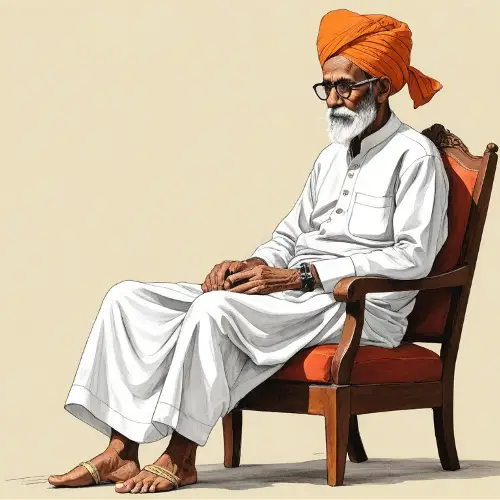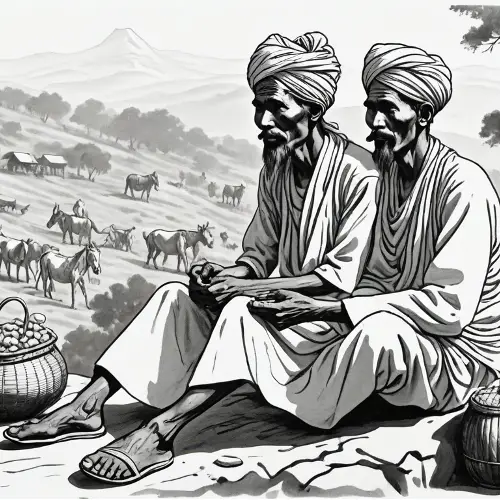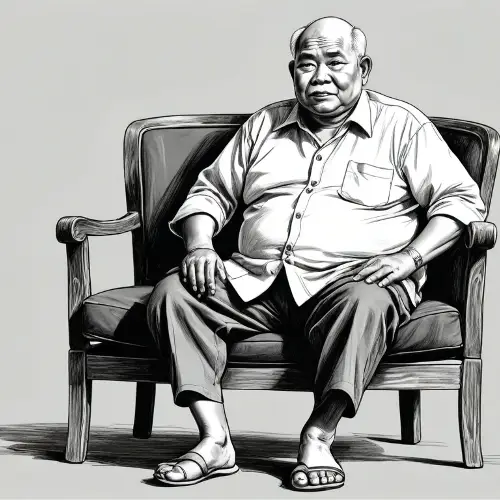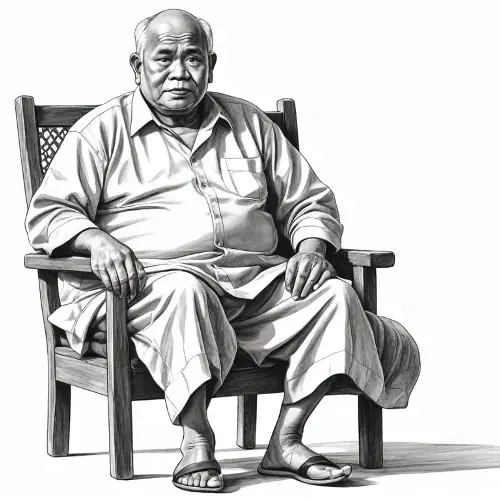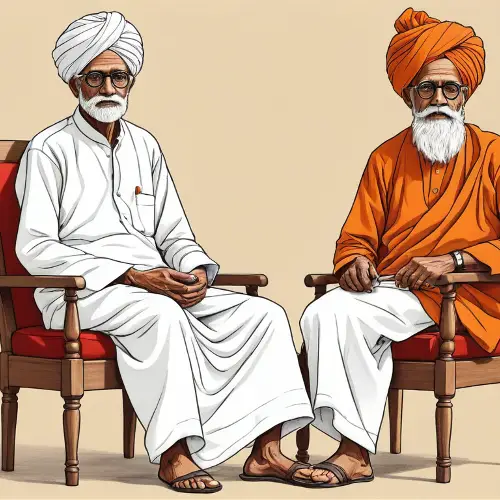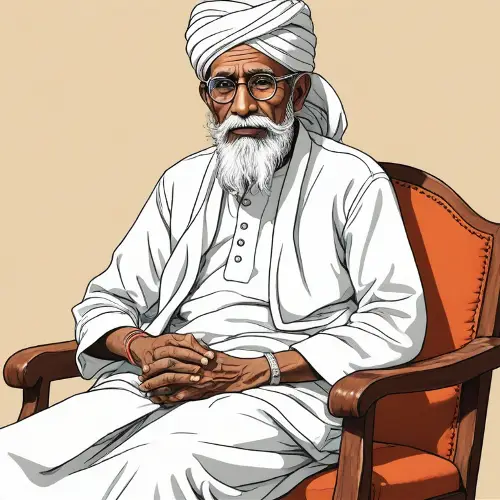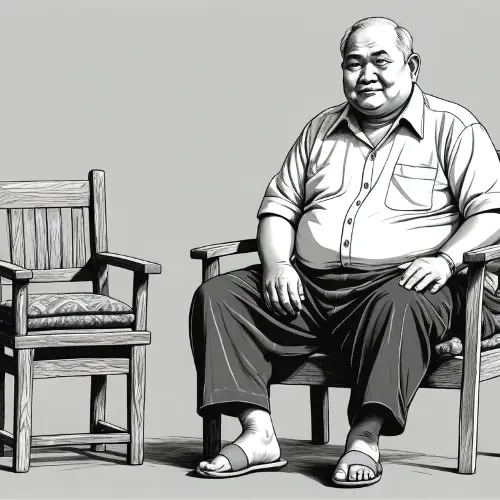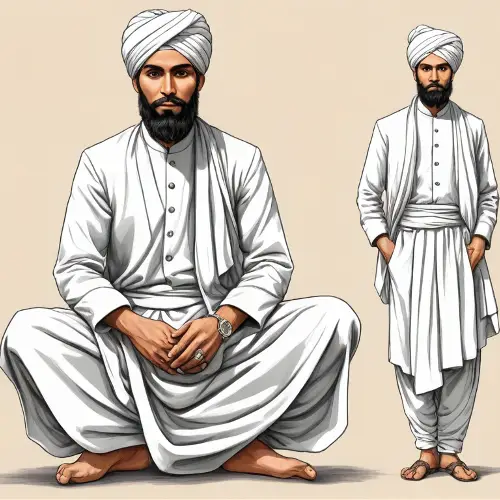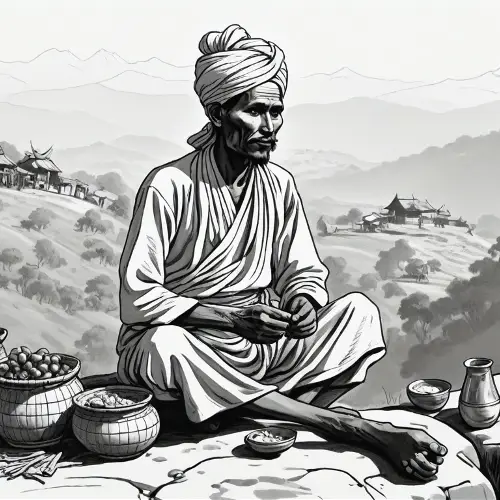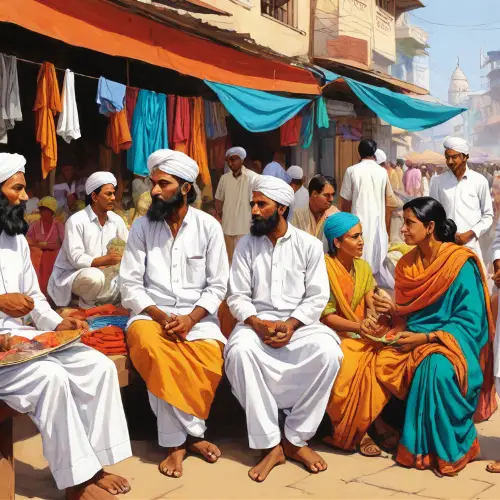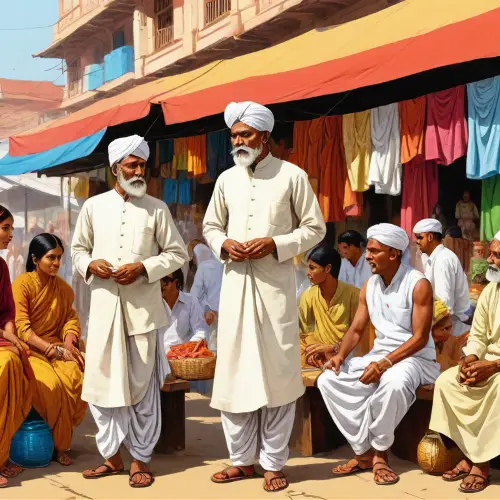Generate an image of a bustling 1940s theater scene in Burma, where the President of Burma stands among a diverse crowd, eagerly watching a captivating performance. The spotlight is on a 13-year-old boy dressed as King Ashoka, delivering a spellbinding theatrical performance, surrounded by intricate props and set pieces that transport the audience to ancient times. Capture the atmosphere of anticipation, cultural richness, and historical resonance in this visually compelling moment. greyscale.
The Marwadi School Stage in Burma in 1935 serves as the backdrop for a nostalgic sketch. Picture a modest stage within the school, embodying the architectural and cultural elements of the Marwadi community. Capture the simplicity of the setting with wooden structures and basic decor. On the stage, imagine students dressed in traditional Marwadi attire, engaged in a cultural or educational event. Symbolic elements, such as books, chalkboards, and cultural artifacts, can be incorporated. The sketch should evoke the essence of education, community, and cultural exchange within the Marwadi school in Burma during the mid-20th century.
In a dimly lit Burmese hospital room in 1885, a Marwadi man lies on a wooden bed with closed eyes, wearing a vibrant turban and covered by an intricately patterned blanket. The atmosphere is serene, with a mix of curious onlookers, patients, and concerned family members surrounding him. A dedicated doctor, dressed in period-appropriate attire, examines a medical chart nearby. The scene captures a multicultural tapestry of Burma in the late 19th century, with soft lighting creating a poignant moment of cultural convergence and compassion.
1940s comic style, chinese woman, masked suprhero, singing, red costume, high heels
LINE ART SKETCH OF MAN WEARING TURBAN DHOTI KURTA SEATING ON HALF SEATED POSITION ON STREET OF BURMA IN 1880
Imagine a scene in the hill area of Burma in the year 1880. A distinguished man is depicted, wearing a traditional turban, kurta, and dhoti, standing with a sense of grace. His attire is detailed, reflecting the cultural nuances of the region during that period. Beside him, a mule is tethered. The landscape around is hilly, with lush vegetation and perhaps a glimpse of distant mountains. The man may be holding a piece of luggage or engaged in an activity, further emphasizing the context of life in Burma during the late 19th century.
Imagine a scene in the hill area of Burma in the year 1880. A distinguished man is depicted, wearing a traditional turban, kurta, and dhoti, standing with a sense of grace. His attire is detailed, reflecting the cultural nuances of the region during that period. Beside him, a mule is tethered, carrying goods or belongings, adding an element of daily life in the hills. The landscape around is hilly, with lush vegetation and perhaps a glimpse of distant mountains. The man may be holding a piece of luggage or engaged in an activity, further emphasizing the context of life in Burma during the late 19th century.
Imagine a scene in the hill area of Burma in the year 1880. A distinguished man is depicted, wearing a traditional turban, kurta, and dhoti, standing with a sense of grace. His attire is detailed, reflecting the cultural nuances of the region during that period. Beside him, a mule is tethered, carrying goods or belongings, adding an element of daily life in the hills. The landscape around is hilly, with lush vegetation and perhaps a glimpse of distant mountains. The man may be holding a piece of luggage or engaged in an activity, further emphasizing the context of life in Burma during the late 19th century.
Imagine a scene in the hill area of Burma in the year 1880. A distinguished man is depicted, wearing a traditional turban, kurta, and dhoti, standing with a sense of grace. His attire is detailed, reflecting the cultural nuances of the region during that period. Beside him, a mule is tethered, carrying goods or belongings, adding an element of daily life in the hills. The landscape around is hilly, with lush vegetation and perhaps a glimpse of distant mountains. The man may be holding a piece of luggage or engaged in an activity, further emphasizing the context of life in Burma during the late 19th century.
Create a sketch capturing the cultural fusion in a bustling market scene in Burma circa 1880. Focus on a Marwadi man, dressed in a traditional dhoti and kurta, actively engaged in selling cloth materials. The man could be showcasing vibrant textiles characteristic of Marwadi culture.
Envision a scene in the hilly terrain of Burma in the year 1880. A man, adorned in a turban and traditional doti, is seated on a rock or a makeshift surface, savoring a meal. His attire is intricately detailed, reflecting the cultural identity of the region during that period. Beside him, a mule is securely tied, and luggage is neatly arranged nearby, suggesting a pause in a journey or a moment of rest during travel. The hilly backdrop features rugged landscapes, with vegetation and perhaps a glimpse of a winding trail or distant hills. The scene captures a serene moment in the daily life of Burmas hill areas in the late 19th century
45 years old man in burma. wearing lungi and sitting on traditional burmese chair. he is a little fat.charcoal style
25 year old burmese born indian man wearing burmese lungi and he is a little fat seen from backside full body. he is entering a pagoda cell. charcoal style, black and white
\"Generate a finely detailed line drawing depicting a 60-year-old Marwari man seated on a Burmese comfort chair, showcasing his side profile. The man is attired in a classic dhoti, complemented by a white Rajasthani turban. Pay special attention to the folds and textures of the dhoti, and capture the intricate details of the turban. Ensure that the man's spectacles are intricately portrayed, and emphasize the cultural fusion in this cross-cultural representation. Utilize precise lines and shading to convey the essence of the man's attire and the unique Burmese comfort chair.\" pencil drawing.
55 years old man in burma. wearing lungi and sitting on traditional burmese chair. he is a little fat.charcoal style
Create a sketch capturing the cultural fusion in a bustling market scene in Burma circa 1880. Focus on a Marwadi man, dressed in a traditional dhoti and kurta, actively engaged in selling cloth materials. The man could be showcasing vibrant textiles characteristic of Marwadi culture. Detail the merchants attire, paying attention to the intricacies of the dhoti and kurta, as well as any accessories that might signify his cultural background. Emphasize the array of fabrics and textiles displayed in his stall, depicting the rich colors and textures indicative of the cloth trade during that era. Surround the Marwadi cloth merchant with the diverse sights of the market – other stalls, customers exploring, and perhaps fellow merchants. Incorporate architectural elements of the market, suggesting the traditional structures and ambiance of a Burmese market in the late 19th century. Consider the play of light and shadow on the fabrics, creating depth and visual interest in the scene. Capture the expressions on the faces of the merchant and potential customers, conveying the lively interaction in this cultural exchange. In essence, aim to portray the dynamic cultural commerce as the Marwadi man brings the vibrancy of his textiles to the bustling marketplace of 1880 Burma.
Create a sketch capturing the cultural fusion in a bustling market scene in Burma circa 1880. Focus on a Marwadi man, dressed in a traditional dhoti and kurta, actively engaged in selling cloth materials. The man could be showcasing vibrant textiles characteristic of Marwadi culture. Detail the merchants attire, paying attention to the intricacies of the dhoti and kurta, as well as any accessories that might signify his cultural background. Emphasize the array of fabrics and textiles displayed in his stall of the cloth trade during that era. Surround the Marwadi cloth merchant with the diverse sights of the market – other stalls, customers exploring, and perhaps fellow merchants. Incorporate architectural elements of the market, suggesting the traditional structures and ambiance of a Burmese market in the late 19th century
Create a sketch capturing the cultural fusion in a bustling market scene in Burma circa 1880. Focus on a Marwadi man, dressed in a traditional dhoti and kurta, actively engaged in selling cloth materials. The man could be showcasing vibrant textiles characteristic of Marwadi culture. Detail the merchants attire, paying attention to the intricacies of the dhoti and kurta, as well as any accessories that might signify his cultural background. Emphasize the array of fabrics and textiles displayed in his stall, depicting the rich colors and textures indicative of the cloth trade during that era. Surround the Marwadi cloth merchant with the diverse sights of the market – other stalls, customers exploring, and perhaps fellow merchants. Incorporate architectural elements of the market, suggesting the traditional structures and ambiance of a Burmese market in the late 19th century. Consider the play of light and shadow on the fabrics, creating depth and visual interest in the scene. Capture the expressions on the faces of the merchant and potential customers, conveying the lively interaction in this cultural exchange. In essence, aim to portray the dynamic cultural commerce as the Marwadi man brings the vibrancy of his textiles to the bustling marketplace of 1880 Burma.
60 year old man in burma sitting on a traditional burmese chair. charcoal style
60 year old man in burma sitting on a traditional burmese chair. charcoal style
Generate a detailed line art sketch featuring a Marwadi man seated on a Burmese market street in 1887. The man is wearing a traditional turban and dhoti, facing left, and engaged in selling cloth materials on street . Capture the intricate details of his attire, the texture of the fabrics on display, and the historical elements of the bustling Burmese market. Illustrate the street scene with architectural nuances and the lively atmosphere of customers exploring the textile offerings. Emphasize the cultural exchange and trade dynamics in this snapshot of 1887 Burma
Generate a detailed line art sketch featuring a Marwadi man seated on a Burmese market street in 1887. The man is wearing a traditional turban and dhoti, facing left, and engaged in selling vibrant cloth materials. Capture the intricate details of his attire, the texture of the fabrics on display, and the historical elements of the bustling Burmese market. Illustrate the street scene with architectural nuances and the lively atmosphere of customers exploring the textile offerings. Emphasize the cultural exchange and trade dynamics in this snapshot of 1887 Burma
Generate a detailed line art sketch featuring a Marwadi man half seated position on a Burmese market street in 1887. The man is wearing a traditional turban and dhoti, facing left, and engaged in selling cloth materials on street . C historical elements of the bustling Burmese market. Illustrate the street scene with architectural nuances and the lively atmosphere of customers exploring the textile offerings.
Create a minimalist one-line sketch featuring a 60-year-old Marwari man in a dhoti and Rajasthani turban, seated on a Burmese comfort chair with a side view. Highlight the essential details such as the turban, dhoti folds, and the silhouette of spectacles, capturing the fusion of Marwari and Burmese cultural elements in a single continuous line
Imagine an Indian man in the hilly region of Burma in 1880. Hes sitting on a rock or a simple surface, wearing a MARWADI THIN turban and a traditional doti. The man is depicted enjoying a meal in a serene setting. Beside him, a mule is securely tied, and luggage is neatly arranged, indicating a moment of rest during a journey. The hilly landscape features rugged terrains with greenery and perhaps a glimpse of a winding trail or distant hills. This scene captures a peaceful moment in the daily life of an individual in the hill areas of Burma during the late 19th century.
60 year old little fat man in burma wearing lungi and sitting on a traditional burmese chair. charcoal style.
On a modern stage, at the center of the stage is a handsome young man dressed in simple silver Chinese armor, with thick eyebrows, black eyes, black long hair combed into a high ponytail, and injuries on his body. The stage is disrupted by this young man, and panoramic shots are taken
Create a minimalist one-line sketch featuring a 60-year-old Marwari man in a dhoti and Rajasthani turban, seated on a Burmese comfort chair with a side view. Highlight the essential details such as the turban, dhoti folds, and the silhouette of spectacles, capturing the fusion of Marwari and Burmese cultural elements in a single continuous line. line sketch
60 year old little chubby man in burma wearing lungi and sitting on a traditional burmese chair. charcoal style.
To create a line art sketch of a Marwadi man wearing a turban, dhoti, and kurta, seating on a wide street of Burma in 1880 while selling cloth material, you can follow these steps: Basic Outline: Start with a rough outline of the seated man. Capture the pose with a half-seated position, focusing on the turban, dhoti, and kurta. Clothing Details: Add details to the clothing, emphasizing the folds and patterns of the dhoti and kurta. Pay attention to the turban, ensuring it reflects the traditional style. Seating Position: Define the seating position by sketching the ground or a makeshift seating arrangement. Consider adding a simple depiction of the cloth materials around the man. Street Details: Expand the sketch to include the wide street. Illustrate the ground, and add elements like cobblestones or patterns to suggest the historical setting. Include a hint of surrounding buildings or shops. Cloth Materials: Draw the cloth materials displayed for sale. Use lines and shading to convey the textures and patterns of the fabrics. Consider adding folds and drapes to make the textiles appear realistic. Facial Features: Add facial features to the man, focusing on his expression. Capture the sense of engagement and perhaps a welcoming or contemplative expression. Final Details: Refine the sketch by adding finer details, such as accessories, patterns on the clothing, and any additional elements that enhance the overall composition. Remember, this is a simplified guide, and you can adjust the details based on your preferences and artistic style. Feel free to experiment with different line weights, shading techniques, and textures to bring your sketch to life.
Imagine an Indian man in the hilly region of Burma in 1880. Hes sitting on a rock or a simple surface, wearing a turban and a traditional doti. The man is depicted enjoying a meal in a serene setting. Beside him, a mule is securely tied, and luggage is neatly arranged, indicating a moment of rest during a journey. The hilly landscape features rugged terrains with greenery and perhaps a glimpse of a winding trail or distant hills. This scene captures a peaceful moment in the daily life of an individual in the hill areas of Burma during the late 19th century.
A child is performing a character from a drama work with animated and expressive movements, drawing the attention of the audience.
A child is performing a character from a drama work with animated and expressive movements, drawing the attention of the audience.
Sketch a vibrant scene capturing the cultural dynamism of a Burmese market in 1880, with a focus on a Marwadi man wearing a traditional dhoti and kurta, actively engaged in selling cloth materials while seated. Surround the merchant with the lively atmosphere of the market, including other shops and people engaging in transactions. Detail the Marwadi mans attire with precision, showcasing the intricacies of the dhoti and kurta, and emphasize the array of cloth materials on display. Illustrate the surrounding market scene with architectural elements, such as nearby shops or stalls, and include a diverse group of people, some browsing and others engaged in purchasing textiles.
Generate authentic and culturally immersive images depicting a group of young students, approximately 6 years old, engaging in playful gossiping, commenting, and teasing with their teacher in a Myanmar classroom during the year 1928. Pay careful attention to historical accuracy, capturing the period-specific clothing, school setting, and cultural details reflective of early 20th-century Myanmar. Convey the innocent yet mischievous spirit of the children as they interact with their teacher, highlighting the universal aspects of childhood experiences within the unique historical context of Myanmar in 1928. Create a scene that reflects the timeless dynamics of student-teacher relationships in a bygone era.\
25 year old burmese born indian man wearing burmese lungi and jacket a little fat seen front side full body . he is coming out of a pagoda meditation cell. charcoal style, black and white
15 year old marwadi boy performing on a stage as a king ashoka. sepia tone
















